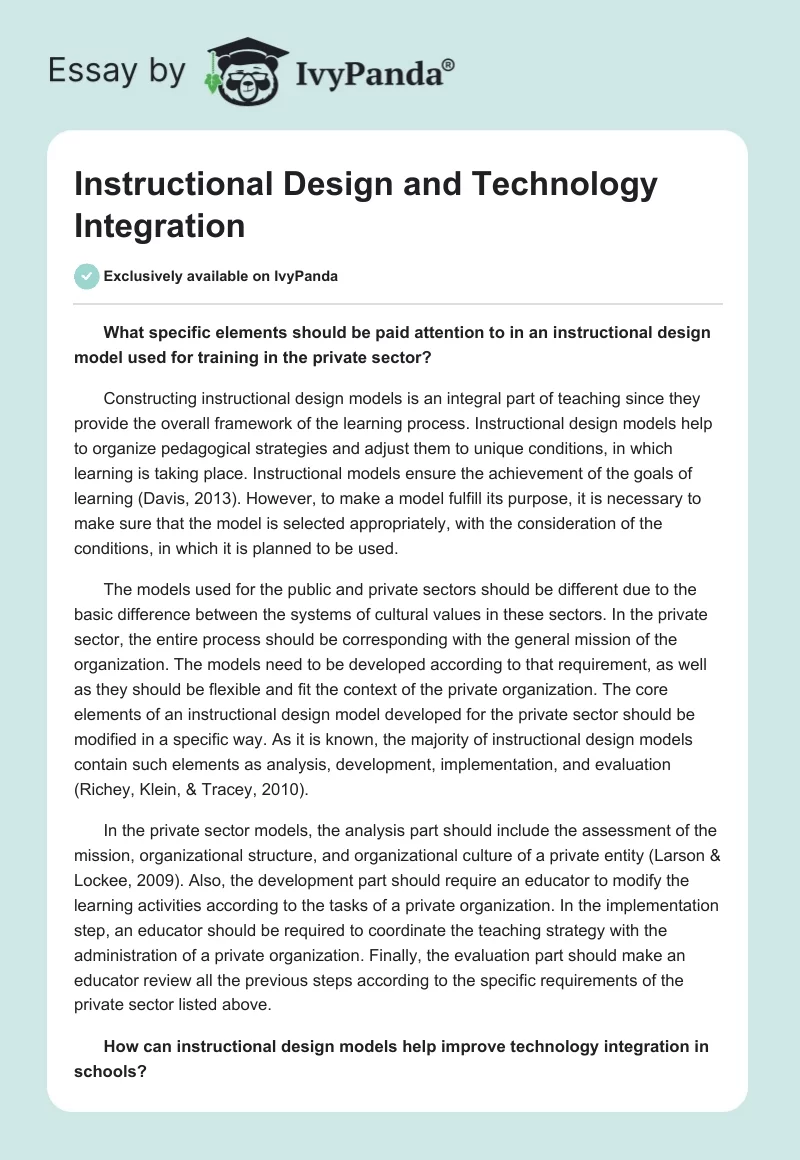What specific elements should be paid attention to in an instructional design model used for training in the private sector?
Constructing instructional design models is an integral part of teaching since they provide the overall framework of the learning process. Instructional design models help to organize pedagogical strategies and adjust them to unique conditions, in which learning is taking place. Instructional models ensure the achievement of the goals of learning (Davis, 2013). However, to make a model fulfill its purpose, it is necessary to make sure that the model is selected appropriately, with the consideration of the conditions, in which it is planned to be used.
The models used for the public and private sectors should be different due to the basic difference between the systems of cultural values in these sectors. In the private sector, the entire process should be corresponding with the general mission of the organization. The models need to be developed according to that requirement, as well as they should be flexible and fit the context of the private organization. The core elements of an instructional design model developed for the private sector should be modified in a specific way. As it is known, the majority of instructional design models contain such elements as analysis, development, implementation, and evaluation (Richey, Klein, & Tracey, 2010).
In the private sector models, the analysis part should include the assessment of the mission, organizational structure, and organizational culture of a private entity (Larson & Lockee, 2009). Also, the development part should require an educator to modify the learning activities according to the tasks of a private organization. In the implementation step, an educator should be required to coordinate the teaching strategy with the administration of a private organization. Finally, the evaluation part should make an educator review all the previous steps according to the specific requirements of the private sector listed above.
How can instructional design models help improve technology integration in schools?
In contemporary education, learners have to receive access to technology and know-how to use it to be prepared for the conditions and requirements of the business environment. The process of integrating technology into teaching is complicated and requires altering the existing standards and adjusting to the constant changes in technology development, which is a complicated task for educators. To assist educators in this work, designers create instructional design models that help to integrate technology into the learning process at schools (Wang, Ertmer, & Newby, 2004).
Using instructional design models gives general guidelines, relying on which, teachers become able to develop the teaching strategies that both correspond to the local conditions, requirements, and tasks and address the audience with a particular level of technical competency, skills, and knowledge. Besides, instructional design models help teachers to integrate the existing theoretical base of learning and apply theories to practice to improve the integration of technology into the learning process (Summerville & Reid-Griffin, 2008).
To bring technology integration in schools on a higher level, instructional design models have to include four specific stages of technology adoption: initial setup, in which the goals and vision are established; teacher preparation, in which the evaluation of needs is performed; curricular reform, in which the necessary regulatory changes are implemented; and proceeding to practice, in which the actual, practical use of technology begins. Additionally, a model should explain how an educator can address the existing barriers to improving technology integration in learners. A model should also include specific strategies, such as establishing a culture of technology use, establishing teachers as role models, and modeling the use of technology (Kopcha, 2010).
References
Davis, A.L. (2013). Using instructional design principles to develop effective information literacy instruction. College & Research Libraries News, 74(4), 205-207. Web.
Kopcha, T.J. (2010). A systems-based approach to technology integration using mentoring and communities of practice. Educational Technology Research and Development, 58(2), 175-190. Web.
Larson, M.B., & Lockee, B.B. (2009). Preparing instructional designers for different career environments: A case study. Educational Technology Research and Development, 57(1), 1-24. Web.
Richey, R.C., Klein, J.D., & Tracey, M.W. (2010). The instructional design knowledge base: theory, research, and practice. New York City, New York: Routledge. Web.
Summerville, J., & Reid-Griffin, A. (2008). Technology integration and instructional design. Tech Trends, 52(5), 45-51. Web.
Wang, L., Ertmer, T.A., & Newby, T.J. (2004). Increasing preservice teachers’ self-efficacy beliefs for technology integration. Journal of Research on Technology in Education, 36(3), 231-250. Web.


